you are here [x]: Scarlet Star Studios > the Scarlet Letters > animating: sand, paint, shadow
<< before
compositing, retro-style
after >>
scenes from "Explorations in Super8"
January 15, 2006
animating: sand, paint, shadow
by sven at 6:00 pm
For the Super8 final project I tried out several animation techniques that I've read about, but never had enough interest in to actually pursue: sand, paint, and shadow.
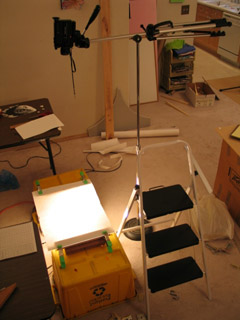
Animating sand and animating paint both had a similar setup. You work on a horizontal piece of glass, lit from below. You put your sand or paint on top of this glass, and film with the camera above.
The super8 camera has a minimum focal distance of 4 feet (unless you use macro). My sheet of acrylic "glass" was raised up about 18" off the ground by two recycling bins. This meant I needed to get the camera pretty high up in the air -- and it had to point directly down, which the tripod wasn't built to do.
So, I took the camera and tripod as one piece and put them in a microphone stand! ...A little wobbly, but a very workable solution.
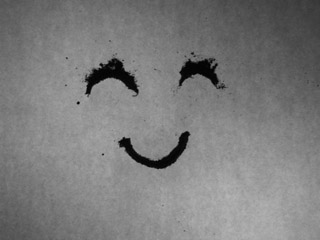
With sand, I put a piece of white butcher paper on top of the glass -- to prevent scratching, and to diffuse light. I didn't have any proper sandbox sand around, so I used some of Gretchin's dry concrete mix instead. Concrete has lye in it, so I was careful to wear latex gloves while working with the grit.
Sand was kinda fun to work with. ...Dropping pinches of it onto the glass wasn't very precise -- and trying to pick it back up to move it somewhere else was fairly irritating... But pushing around little lines was pleasant. And spreading sand across the whole sheet and then making lines with negative space was also pretty good -- so long as the image didn't need to be very fussy.
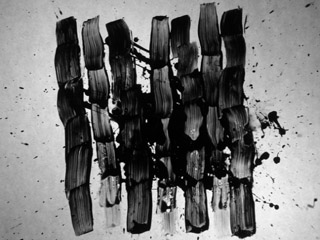
For animating paint, I took the sheet of paper off the top of the glass and instead clamped it onto the underside. I started off by dripping black tempera paint onto the slick surface -- Jackson Pollock style -- and then proceeded to move it around with brushes (occasionally re-wetting the surface).
This I liked a lot. It was very much like finger-painting: the process being more about moving paint around than capturing a single static image. And the light shining up through the glass really illuminated the texture of the brush strokes nicely. Just beautiful.
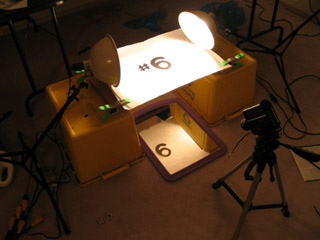
For filming shadows, I needed to change the camera setup. I put the white butcher paper back on top of the glass, and pointed the lights downward at it. The shadow puppets sit on top, held in place by gravity. The image I wanted to capture was going to be underneath the glass.
If the camera were directly underneath the glass, then the glass would have to be at least four feet up in the air (due to focal distance). That would have been really awkward to work with. So instead, I put a mirror on the floor, and pointed the camera at that. The focal distance was measured not from the camera to the mirror -- but rather from the camera to the mirror and then up to the glass.
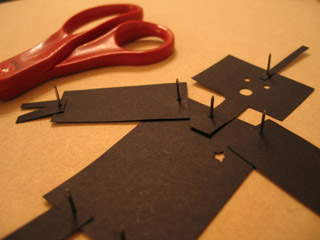
Shadow puppets are typically hinged with thread, I believe. But I was feeling lazy. I wanted to use brads (the metal fasteners you find on large manilla envelopes) -- but we didn't have any on hand. So, in a pinch, I used small wire nails for my joints. Pointy -- but effective!
The robot pictured above was cute, but not a very practical puppet. The shoulders would bump into the neck if I moved them too far. If I make shadow puppets again, I must remember to make sure that none of the joints interfere with each other.
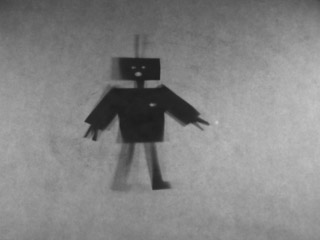
Animating the shadow puppet was a real pleasure when I was only moving one limb at a time. The arms moved wonderfully smoothly. But when I had to move the whole body -- that was trouble. All the joints would flail wildly, dragging behind the main torso.
Another problem I ran into was bad lighting. Because it was easiest to just lean the lights inward, I had beams coming from two sides. The puppet didn't always lie totally flat upon the glass, which meant that side-lighting could wash out some of the shadows I was trying to create. If I had had light coming from directly above, it probably wouldn't have mattered so much if the puppet wasn't lying entirely flat; all the shadows would be perpendicular to the glass.
Conclusion: Having known about these animation techniques for years, I'm glad to have actually tried them now. I doubt that I'll return to them any time soon... But if I do, I expect it'll be paint that I pick up again. It has a really lovely improvisational quality about it -- and it would be interesting to see what I could do with it if I were working in color. Any serious work, though, would probably require oil points -- which is an investment I'm not quite ready to spring for yet.
posted by sven | January 15, 2006 6:00 PM | categories: movies, stopmo